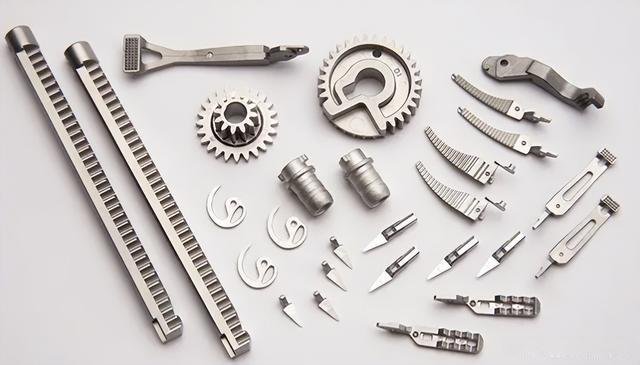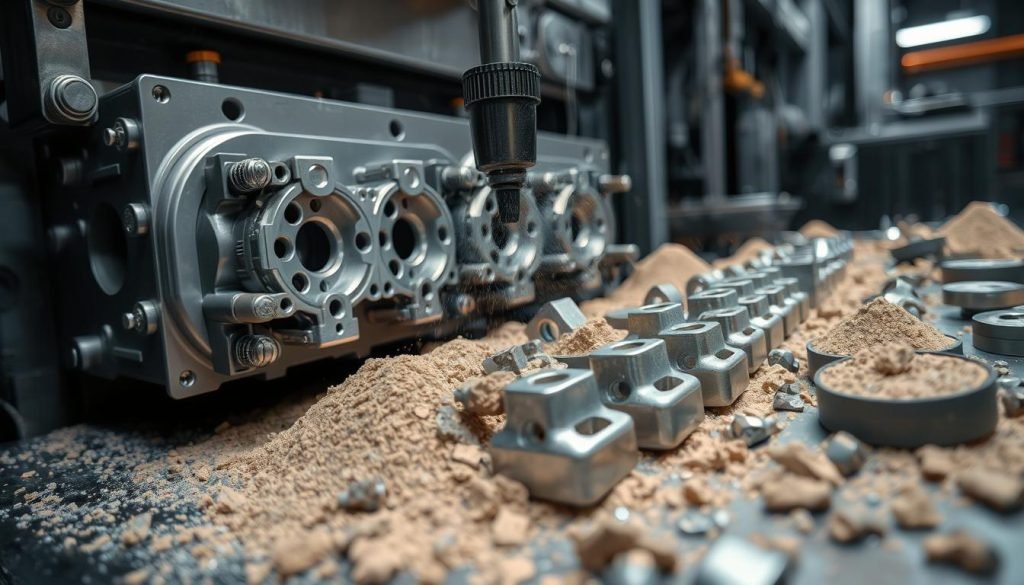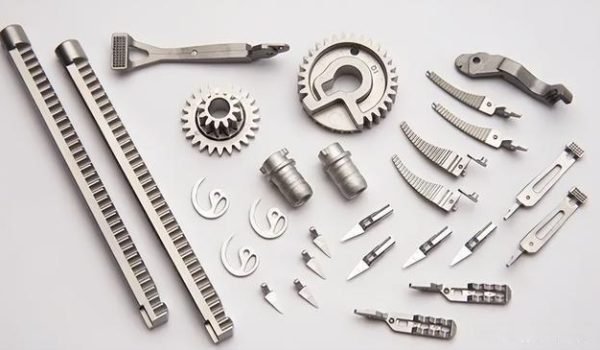The metal injection molding process has changed the game in manufacturing. It combines the best of plastic injection molding with metal’s strength. This tech, known as MIM technology, makes complex metal parts with great precision.
It’s a game-changer for industries like automotive and aerospace. It lets them make parts with detailed designs and tight tolerances.
Knowing about metal injection molding and MIM technology is key for industries looking to use it. The question of whether metal can be injection molded is about what this tech can do. As we explore metal injection molding, it’s clear it’s a big deal. It brings together precision, strength, and durability in a unique way.
Understanding Metal Injection Molding (MIM)
Metal injection molding is a complex process that needs a good understanding of its basics. To get the MIM concept, it’s key to explore its definition, history, and advantages. The MIM definition is about mixing metal powders with a binder. This mix is then injected into a mold to shape the desired part.

The history of MIM started in the 1970s, with big improvements over time. These advancements have made it possible to create detailed parts with high precision. This makes MIM a great choice for making small, complex parts.
Some key advantages of metal injection molding include:
- Ability to produce complex geometries
- High precision and accuracy
- Use of a wide range of metals and alloys
These benefits make MIM a good option for many industries like automotive, medical, and aerospace. Knowing about MIM’s definition, history, and advantages helps manufacturers make high-quality parts with precision.
The MIM process has several stages, from making the feedstock to sintering. Each stage is important for the final product’s quality and properties. As the need for complex metal parts grows, understanding MIM will become more important.
| Stage | Description |
|---|---|
| Feedstock Preparation | Mixing metal powders with a binder to create a feedstock |
| Injection Phase | Injecting the feedstock into a mold to form the desired shape |
| Debinding Process | Removing the binder from the molded part |
| Sintering | Heating the part to achieve the desired properties |
Common Metals Used in Injection Molding
Metals used in MIM have many properties. They are good for different uses. The metal choice depends on the product’s needs, like strength and durability.
Steel alloys, titanium, and nickel alloys are often used. Steel alloys are strong and last long, perfect for high-performance needs. Titanium is great for aerospace and medical fields because it’s strong yet light.
Here are some key traits of metals in MIM:
- Steel alloys in MIM: high strength, durability, and resistance to wear and tear
- Titanium in MIM: high strength-to-weight ratio, corrosion resistance, and biocompatibility
- Nickel alloys in MIM: excellent corrosion resistance, high temperature resistance, and durability
In conclusion, MIM’s variety of metals lets us make complex parts with special properties. It’s a versatile and valuable way to make things.
| Metal | Properties | Applications |
|---|---|---|
| Steel Alloys | High strength, durability | Aerospace, automotive, industrial |
| Titanium | High strength-to-weight ratio, corrosion resistance | Aerospace, medical, sports equipment |
| Nickel Alloys | Excellent corrosion resistance, high temperature resistance | Chemical processing, aerospace, automotive |
The MIM Process Explained
The Metal Injection Molding (MIM) process turns metal powders into complex, precise parts. It’s important to know each step to make the best metal parts. First, metal powders are mixed with a binder to make a uniform mix.
Feedstock Preparation and Injection
This mix is then injected into a mold. It takes the mold’s shape, which is key for the part’s final look and size.
Debinding and Sintering
Next, the part goes through debinding to remove the binder. Then, it’s sintered at high heat. This fuses the metal powders into a solid, dense part. Sintering is key for the part’s final properties.
| MIM Process Step | Description |
|---|---|
| Feedstock Preparation | Mixing metal powders with a binder |
| Injection Phase | Injecting the feedstock mixture into a mold |
| Debinding Process | Removing the binder from the injected part |
| Sintering in MIM | Heating the part to fuse the metal powders together |
Applications of Metal Injection Molding
Metal injection molding (MIM) is used in many industries. It’s great for making complex shapes and precise parts. In the car world, MIM helps make automotive parts like engine parts and gearboxes.
In medicine, MIM makes medical devices like surgical tools and implants. It’s perfect for creating detailed shapes and structures. This is key for making medical devices that need to be precise and safe for the body.
- Automotive industry: automotive parts such as engine components and gearboxes
- Medical field: medical devices such as surgical instruments and implantable devices
- Aerospace industry: production of lightweight, high-strength components
MIM brings many benefits to these industries. It makes production faster, cheaper, and better quality. As we need more complex and precise parts, MIM will likely be used even more.
| Industry | MIM Application | Benefits |
|---|---|---|
| Automotive | Engine components | Increased efficiency, reduced production costs |
| Medical | Surgical instruments | Improved product quality, biocompatibility |
| Aerospace | Lightweight components | Reduced weight, increased strength |
Comparing MIM with Traditional Metalworking
When we look at metal injection molding (MIM) and traditional metalworking, MIM shines. It’s all about efficiency in MIM. This method makes complex parts quickly, with little need for extra work. This means faster production and less waste.
MIM also uses materials better, cutting down on waste. It lets designers make parts with detailed shapes that old methods can’t handle. This opens up new possibilities for designs.
The table below shows how MIM stacks up against traditional metalworking:
| Characteristic | MIM | Traditional Metalworking |
|---|---|---|
| Efficiency | Higher production speeds, minimal post-processing | Lower production speeds, more post-processing required |
| Material Utilization | Better material utilization, reduced waste | Poorer material utilization, more waste generated |
| Design Flexibility | Greater design flexibility, intricat geometries possible | Limited design flexibility, simpler geometries |
Challenges in Metal Injection Molding
Metal injection molding (MIM) is a complex process with many benefits. But, it also has its own set of challenges. One major issue is the material limitations of MIM. Not all metals can be used, and the final product’s properties can be affected by the binder and sintering process.
Another big challenge is the cost of MIM. The equipment and process can be very expensive, making it hard for companies with small orders. Also, the challenges in MIM include needing technical expertise. This is needed for material selection, process optimization, and quality control.
Material Limitations and Cost Considerations
- High upfront costs for equipment and setup
- Material limitations that restrict the types of metals that can be used
- Need for technical expertise to optimize the process and ensure quality

Despite these challenges, many companies are finding ways to overcome them. They successfully use MIM for their production needs. By understanding the challenges in MIM and addressing them, companies can benefit from this technology. This helps them stay competitive in their markets.
Quality Control in Metal Injection Molding
Ensuring the quality of metal injection molded (MIM) parts is key. Quality control in MIM uses many inspection methods. These include checking dimensions and testing material properties to ensure parts work as expected.
Some important inspection techniques in MIM are:
- Dimensional inspection to check part sizes and tolerances
- Material property testing to see how parts perform mechanically and physically
- Non-destructive testing to find any hidden defects or flaws
Standardization is also vital in MIM. Many parts are made to follow specific industry standards. Standardization makes sure parts fit well with others and meet safety and performance needs.
Quality control in MIM also means controlling the making process. This includes watching the feedstock, injection molding, and sintering. It helps make sure parts are made right and meet quality standards.
| Inspection Technique | Description |
|---|---|
| Dimensional Inspection | Verifies the part’s dimensions and tolerances |
| Material Property Testing | Evaluates the part’s mechanical and physical properties |
| Non-Destructive Testing | Detects internal defects or flaws without damaging the part |
The Future of Metal Injection Molding
The future of metal injection molding (MIM) is bright. Innovations in MIM materials and technologies are ongoing. Researchers are working on new materials and binder systems. This is to make MIM parts better and use more metals.
Some key areas for future of MIM development include:
- Advances in sintering furnaces and injection molding machines to enhance efficiency and quality
- Expansion of the range of metals that can be used in MIM, including titanium and nickel alloys
- Improvements in the properties of MIM parts, such as strength and durability
The market trends show a growing need for MIM parts. This is because of the demand for complex, high-precision components in many industries. This demand will help the MIM market grow, opening new opportunities for manufacturers and suppliers.
The future of metal injection molding is full of promise. With ongoing innovations and advancements in technology and materials, the industry will keep evolving. We can look forward to new and innovative uses of MIM, driving growth and development in various fields.
| Area of Development | Description |
|---|---|
| Materials | Research into new materials and binder systems to improve properties of MIM parts |
| Technology | Advances in sintering furnaces and injection molding machines to enhance efficiency and quality |
| Market Trends | Growing demand for MIM parts, driven by need for complex, high-precision components |
Conclusion: The Viability of MIM
Metal injection molding (MIM) is a versatile and promising process. It’s gaining traction in many industries. It can make complex, high-precision parts and work with many materials, making it a good alternative to traditional methods.
Summary of Key Points
MIM has several key advantages. It’s efficient, uses materials well, and is flexible in design. It’s great for making detailed metal parts, which is why it’s popular in the automotive, medical, and aerospace fields. Even though there are challenges, like material limits and needing technical skills, new innovations are helping to solve these problems.
Final Thoughts on Metal Injection Molding
The demand for complex, high-performance parts is rising. This makes the future of MIM look bright. It can make a wide variety of metal parts, which opens up new markets and uses. As the industry keeps growing, MIM will become even more valuable, becoming a key part of modern manufacturing.




